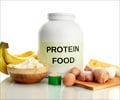Power your plate with high-protein Indian foods! Explore simple, affordable options like paneer, chickpeas, and lentils for a healthier you.

- Protein aids muscle repair, fat loss, satiety, and overall wellness
- Indian foods like dal, paneer, sattu, and chickpeas are affordable protein sources
- Balanced protein-rich meals help sustain energy and recovery
Why is Protein Important?
Protein is often misunderstood as a nutrient meant only for bodybuilders or athletes. However, it serves a much broader purpose. It is involved in various bodily functions, such as:Muscle Growth and Repair:
Protein helps rebuild tissues and muscles, making it indispensable for anyone engaged in physical activity.Satiety and Craving Reduction:
It keeps you feeling fuller for longer, reducing the temptation to snack on unhealthy foods.Fat Loss and Recovery:
High-protein meals support fat loss while preserving muscle mass and aiding quicker recovery after workouts.Overall Wellness:
As a key component of enzymes, hormones, and immune functions, protein is essential for maintaining health and vitality.
Abhi Rajput, a fitness coach specializing in fat reduction, explains that protein is often underestimated in Indian diets. While staples like dal and sattu are recognized sources, there’s a much wider variety of protein-rich foods that can be tapped into. He suggests that protein is the body’s fuel, saying, “It’s the foundation for strength, endurance, and recovery- simply unavoidable.”
High-protein Indian Alternatives
You don’t need exotic ingredients to meet your protein needs. Indian cuisine offers numerous protein-rich options that are both affordable and easy to incorporate into everyday meals. Here are some examples:Lentils (Dal):
A staple in Indian households, dals like masoor, moong, and toor are excellent sources of plant-based protein. A single serving can provide up to 7-9 grams of protein.Sattu (Roasted Gram Flour):
Popular in North India, sattu is a powerhouse of protein, fiber, and essential nutrients. It’s often consumed as a refreshing drink or added to parathas.Paneer (Cottage Cheese):
With approximately 14 grams of protein per 100 grams, paneer is a versatile ingredient that can be used in curries, salads, or snacks.Tofu:
Often considered a vegan alternative to paneer, tofu provides around 8 grams of protein per 100 grams and is ideal for those avoiding dairy.Chickpeas (Chana):
High in protein and fiber, chickpeas can be added to salads, made into hummus, or used in traditional curries.Eggs:
A complete protein source, eggs are easy to prepare and offer about 6 grams of protein per egg.Quinoa:
While not traditionally Indian, quinoa is increasingly being adopted as a high-protein grain alternative.Nuts and Seeds:
Almonds, peanuts, chia seeds, and flaxseeds are rich in protein and healthy fats, making them ideal for snacking.
Simplifying Protein Consumption
Incorporating protein into your meals doesn’t have to be complicated. Fitness experts recommend focusing on accessibility, digestion, and balance. Here are some tips:Start Simple:
Incorporate familiar ingredients like dals, eggs, and paneer into your daily meals.Quantify Your Intake:
Measure portions to ensure you’re consuming the right amount of protein relative to your needs.Balance Your Plate:
Pair protein-rich foods with vegetables and whole grains for a balanced meal.Experiment:
Try blending traditional Indian ingredients with modern recipes, like adding sattu to smoothies or using tofu in stir-fries.
Protein is an indispensable part of a healthy diet, and Indian cuisine offers a wealth of options to meet daily protein requirements. As icons like Neeraj Chopra and Suniel Shetty highlight, a disciplined approach to incorporating protein can lead to improved health, fitness, and overall well-being. Whether you are an athlete, a fitness enthusiast, or someone looking to maintain a balanced diet, these Indian protein alternatives are an easy and effective way to fuel your body. Start small, stay consistent, and let protein power your journey to a healthier life.
References:
- Physiology, Proteins (LaPelusa A, Kaushik R. Physiology, Proteins. [Updated 2022 Nov 14]. In: StatPearls [Internet]. Treasure Island (FL): StatPearls Publishing; 2024 Jan-. Available from: https://www.ncbi.nlm.nih.gov/books/NBK555990/)
Source-Medindia









